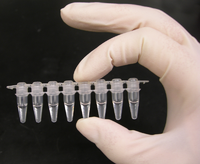
Photo from wikipedia
A novel colorimetric biosensor, which employs DNAzyme-functionalized magnetic beads (MBs) as recognition probe, enzyme-assisted catalytic oxidation of TMB (3,3',5,5'-tetramethylbenzidine sulfate) as signal and DNA hybridization chain reaction as amplification strategy,… Click to show full abstract
A novel colorimetric biosensor, which employs DNAzyme-functionalized magnetic beads (MBs) as recognition probe, enzyme-assisted catalytic oxidation of TMB (3,3',5,5'-tetramethylbenzidine sulfate) as signal and DNA hybridization chain reaction as amplification strategy, has been developed for detecting trace uranyl ion (UO22+) in seafood and aqueous environment with high sensitivity and specificity. We demonstrated that UO22+ can specifically cleave DNAzyme immobilized on MBs surface to release a short single-strand DNA (primer), and the released primer trigger DNA hybridization chain reaction to form a long one dimensional DNA concatamer on the MBs surface. The resulting long DNA concatamer could capture a large amount of HRP to generate the one UO22+-to-multiple HRP amplification effect. Upon the addition of TMB-H2O2 solution, the HRP-tagged DNA concatamer-MBs conjugates could catalyze the H2O2-mediated oxidation of TMB, and thus results in a color change from colorless to blue in solution. This provided a sensitive and selective sensing platform for the visual or colorimetric detection of UO22+. The proposed biosensor has high sensitivity and strong anti-interference capability, it can be used to detect as low as 2.5 ppb (9.25 nM) of UO22+ by naked-eye observation and 0.09 ppb (0.33 nM) of UO22+ by UV-visible spectrometry with no interference of other ions and a RSD ≤ 6% (n = 5). With the help of this method, we have successfully determined trace UO22+ in fish muscle and river water with a recovery of 93-106%. High sensitivity and specificity, as well operation convenience, low cost and strong resistibility to the matrix, which makes our method a potential approach for the on-site detection of UO22+ in seafood and aqueous environment.
Journal Title: Analytica chimica acta
Year Published: 2017
Link to full text (if available)
Share on Social Media: Sign Up to like & get
recommendations!